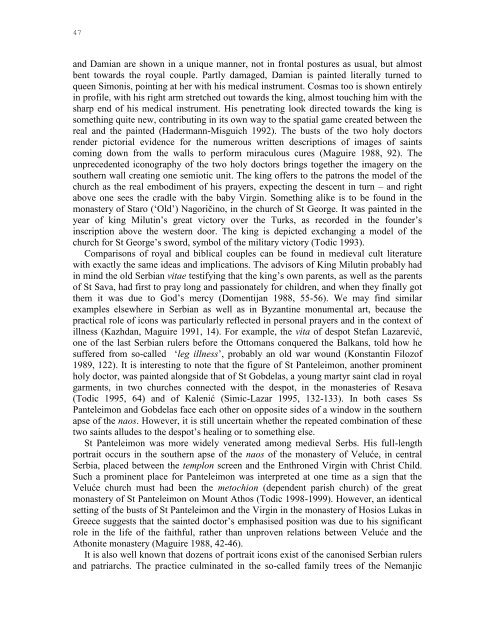You also want an ePaper? Increase the reach of your titles
YUMPU automatically turns print PDFs into web optimized ePapers that Google loves.
47<br />
and Damian are shown in a unique manner, not in frontal postures as usual, but almost<br />
bent towards the royal couple. Partly damaged, Damian is painted literally turned to<br />
queen Simonis, pointing at her with his medical instrument. Cosmas too is shown entirely<br />
in profile, with his right arm stretched out towards the king, almost touching him with the<br />
sharp end of his medical instrument. His penetrating look directed towards the king is<br />
something quite new, contributing in its own way to the spatial game created between the<br />
real and the painted (Hadermann-Misguich 1992). The busts of the two holy doctors<br />
render pictorial evidence for the numerous written descriptions of images of saints<br />
coming down from the walls to perform miraculous cures (Maguire 1988, 92). The<br />
unprecedented iconography of the two holy doctors brings together the imagery on the<br />
southern wall creating one semiotic unit. The king offers to the patrons the model of the<br />
church as the real embodiment of his prayers, expecting the descent in turn – and right<br />
above one sees the cradle with the baby Virgin. Something alike is to be found in the<br />
monastery of Staro („Old‟) Nagoriĉino, in the church of St George. It was painted in the<br />
year of king Milutin‟s great victory over the Turks, as recorded in the founder‟s<br />
inscription above the western door. The king is depicted exchanging a model of the<br />
church for St George‟s sword, symbol of the military victory (Todic 1993).<br />
Comparisons of royal and biblical couples can be found in medieval cult literature<br />
with exactly the same ideas and implications. The advisors of King Milutin probably had<br />
in mind the old Serbian vitae testifying that the king‟s own parents, as well as the parents<br />
of St Sava, had first to pray long and passionately for children, and when they finally got<br />
them it was due to God‟s mercy (Domentijan 1988, 55-56). We may find similar<br />
examples elsewhere in Serbian as well as in Byzantine monumental art, because the<br />
practical role of icons was particularly reflected in personal prayers and in the context of<br />
illness (Kazhdan, Maguire 1991, 14). For example, the vita of despot Stefan Lazarević,<br />
one of the last Serbian rulers before the Ottomans conquered the Balkans, told how he<br />
suffered from so-called „leg illness‟, probably an old war wound (Konstantin Filozof<br />
1989, 122). It is interesting to note that the figure of St Panteleimon, another prominent<br />
holy doctor, was painted alongside that of St Gobdelas, a young martyr saint clad in royal<br />
garments, in two churches connected with the despot, in the monasteries of Resava<br />
(Todic 1995, 64) and of Kalenić (Simic-Lazar 1995, 132-133). In both cases Ss<br />
Panteleimon and Gobdelas face each other on opposite sides of a window in the southern<br />
apse of the naos. However, it is still uncertain whether the repeated combination of these<br />
two saints alludes to the despot‟s healing or to something else.<br />
St Panteleimon was more widely venerated among medieval Serbs. His full-length<br />
portrait occurs in the southern apse of the naos of the monastery of Veluće, in central<br />
Serbia, placed between the templon screen and the Enthroned Virgin with Christ Child.<br />
Such a prominent place for Panteleimon was interpreted at one time as a sign that the<br />
Veluće church must had been the metochion (dependent parish church) of the great<br />
monastery of St Panteleimon on Mount Athos (Todic 1998-1999). However, an identical<br />
setting of the busts of St Panteleimon and the Virgin in the monastery of Hosios Lukas in<br />
Greece suggests that the sainted doctor‟s emphasised position was due to his significant<br />
role in the life of the faithful, rather than unproven relations between Veluće and the<br />
Athonite monastery (Maguire 1988, 42-46).<br />
It is also well known that dozens of portrait icons exist of the canonised Serbian rulers<br />
and patriarchs. The practice culminated in the so-called family trees of the Nemanjic


